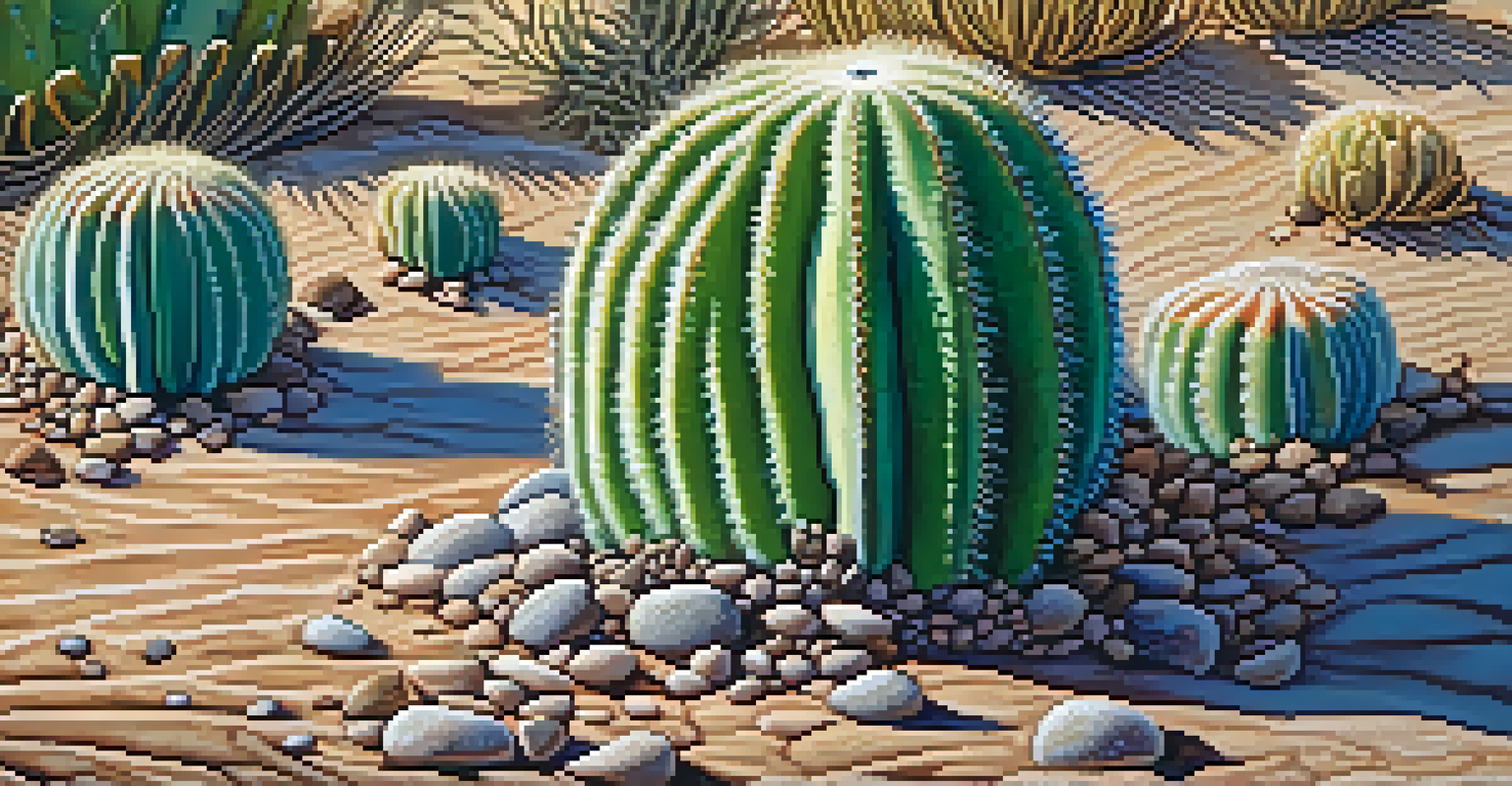Exploring Peyote: Ancient Use and Modern Scientific Inquiry

The Historical Significance of Peyote in Indigenous Cultures
Peyote, a small cactus native to Mexico and the southwestern United States, holds deep significance in various Indigenous cultures. For centuries, tribes such as the Huichol and the Navajo have used it in religious ceremonies, viewing it as a sacred tool for spiritual guidance and healing. The vibrant traditions surrounding Peyote illustrate its role not just as a plant, but as a bridge to the divine.
The use of Peyote is not just a ritual, but a pathway to understanding the self and the universe.
The ritualistic use of Peyote often involves elaborate ceremonies, where participants consume the cactus to seek visions and insights. These practices are steeped in cultural heritage, reflecting a worldview that embraces interconnectedness among all living things. Through these ceremonies, the communities forge a deeper understanding of themselves and their place in the universe.
As we explore the ancient use of Peyote, it is essential to recognize the respect and reverence with which Indigenous peoples approach this plant. Their traditions remind us that Peyote is not merely a substance for recreation but a vital element of their identity and spirituality.
Psychoactive Properties: Understanding Mescaline
At the heart of Peyote's effects is mescaline, a powerful psychoactive compound. When ingested, mescaline alters perception, thought processes, and even emotional states, often leading to profound experiences. Users typically report heightened sensory perception, vivid visual hallucinations, and an intense feeling of connection to nature and others.

Scientific inquiry into mescaline has unveiled its potential therapeutic benefits, particularly in treating conditions like depression and PTSD. Researchers are now exploring how these psychedelic experiences can lead to lasting changes in mental health, echoing some of the traditional beliefs held by Indigenous cultures for centuries. This intersection of ancient wisdom and modern science is particularly fascinating.
Peyote's Sacred Role in Culture
Peyote is revered in Indigenous cultures as a spiritual tool for healing and connection to the divine.
However, it's important to approach mescaline with caution. While many users have positive experiences, the effects can vary widely, and some individuals may experience anxiety or discomfort. Understanding the compound's properties and respecting its power is crucial for a safe experience.
Peyote and the Native American Church: A Unique Relationship
The Native American Church (NAC) plays a pivotal role in the modern use of Peyote, blending traditional practices with contemporary faith. Established in the early 20th century, the NAC provides a legal framework for the use of Peyote in religious ceremonies, protecting the rights of its members to practice their spirituality. This unique relationship highlights the importance of Peyote in fostering community and cultural identity.
In the intersection of ancient wisdom and modern science lies the potential for profound healing.
Within the NAC, Peyote is viewed as a sacrament, central to worship and healing. Members participate in ceremonies that often last throughout the night, engaging in prayer, singing, and communal sharing. This collective experience reinforces bonds among participants and emphasizes the significance of spiritual connection.
The NAC's embrace of Peyote also underscores the ongoing struggle for Indigenous rights and recognition. As the church advocates for its members’ rights to practice their faith, it challenges societal perceptions of Peyote and promotes a greater understanding of its cultural importance.
Modern Scientific Research on Peyote and Mental Health
Recent studies have begun to unlock the therapeutic potential of Peyote, particularly in mental health. Researchers are investigating its effects on conditions like anxiety, depression, and addiction, suggesting that the insights gained during Peyote experiences could lead to meaningful healing. This has sparked a renewed interest in the intersection of psychedelics and therapy.
For example, clinical trials have shown that psychedelics, including mescaline, can lead to significant improvements in mood and well-being. Participants often report lasting positive changes in their outlook on life, relationships, and personal struggles. This aligns with traditional Indigenous beliefs that Peyote can facilitate deep introspection and personal growth.
Therapeutic Potential of Mescaline
Research indicates that mescaline, the psychoactive compound in Peyote, may offer significant mental health benefits.
However, the study of Peyote is not without challenges. Ethical considerations arise when examining the cultural significance of the plant versus its scientific use. Balancing respect for Indigenous traditions with the quest for scientific understanding is a delicate dance that researchers must navigate.
Legal Status of Peyote: Challenges and Progress
The legal status of Peyote is a complex issue, shaped by cultural, religious, and political factors. In the United States, Peyote is classified as a Schedule I substance, making its use illegal outside of specific religious contexts. This has led to ongoing debates about the rights of Indigenous peoples and the need for legal reform.
In recent years, there has been a push for greater recognition of Peyote's cultural significance, particularly as interest in psychedelics grows. Legalizing its use for therapeutic purposes could provide new avenues for healing while respecting traditional practices. Advocates argue that this approach would honor Indigenous knowledge and promote social justice.
Despite these challenges, some progress has been made. Initiatives in various states are exploring how to create frameworks that allow for legal use of Peyote in both religious and therapeutic settings. As these discussions evolve, they may pave the way for a more nuanced understanding of Peyote’s role in society.
Conservation Efforts: Protecting Peyote's Future
As interest in Peyote grows, so do concerns about its sustainability. Overharvesting, habitat loss, and climate change threaten the future of this sacred plant. Conservation efforts are becoming increasingly vital to ensure that Peyote remains available for future generations and continues to hold its cultural significance.
Organizations dedicated to the conservation of Peyote are working with Indigenous communities to implement sustainable harvesting practices. These initiatives not only protect the cactus but also empower Indigenous peoples by preserving their traditions and knowledge. By collaborating with traditional stewards of the land, conservationists can develop strategies that honor cultural practices while addressing ecological concerns.
Conservation of Peyote Is Vital
Sustainable harvesting and conservation efforts are essential to protect Peyote and its cultural significance for future generations.
Moreover, raising awareness about the importance of conserving Peyote can foster a greater appreciation for Indigenous cultures and their relationship with nature. As more people learn about the ecological and cultural value of Peyote, they may feel inspired to support efforts that protect this unique plant.
The Future of Peyote: Bridging Tradition and Innovation
The future of Peyote lies at the intersection of tradition and innovation. As modern science continues to explore its therapeutic potential, there is an opportunity to integrate ancient wisdom with contemporary practices. This fusion could lead to new understandings and applications of Peyote that honor its heritage while addressing current challenges.
Collaboration between Indigenous communities and researchers can pave the way for responsible and respectful use of Peyote. By valuing traditional knowledge alongside scientific inquiry, both parties can contribute to a holistic understanding of the plant's benefits. This partnership can also promote ethical practices that prioritize the well-being of Indigenous peoples and their traditions.

Ultimately, the journey of Peyote is a testament to the resilience of Indigenous cultures and the potential for healing in our modern world. As we continue to explore its ancient roots and modern applications, we must remain mindful of the delicate balance between reverence for tradition and the pursuit of innovation.